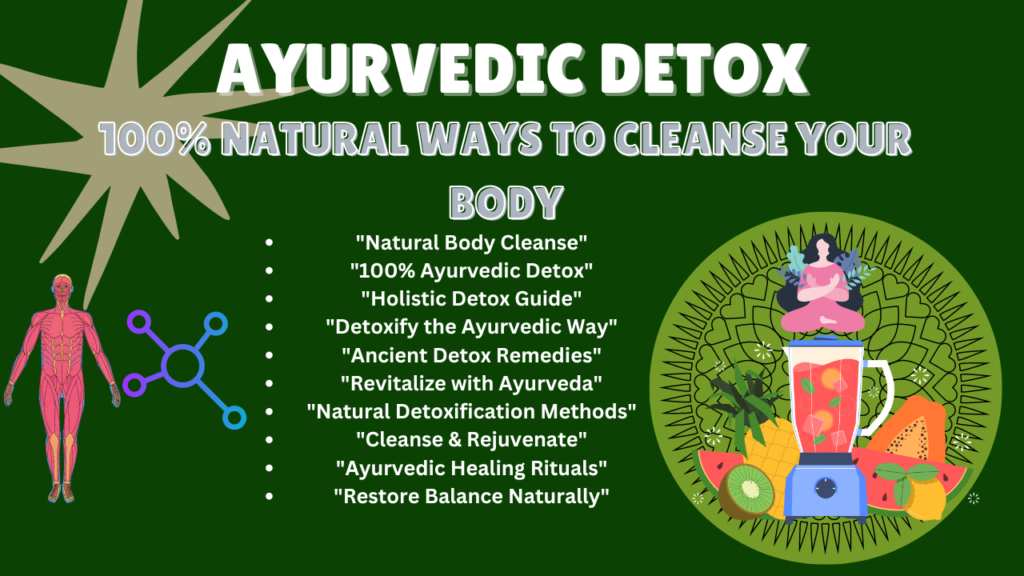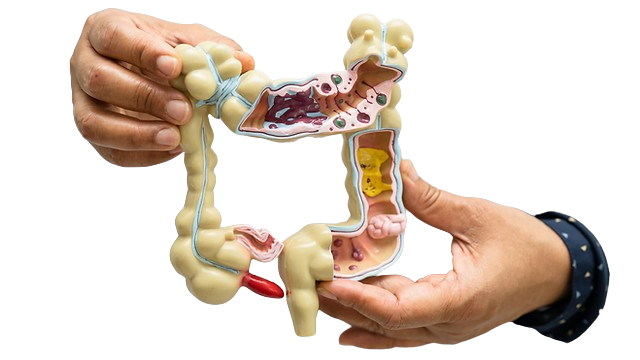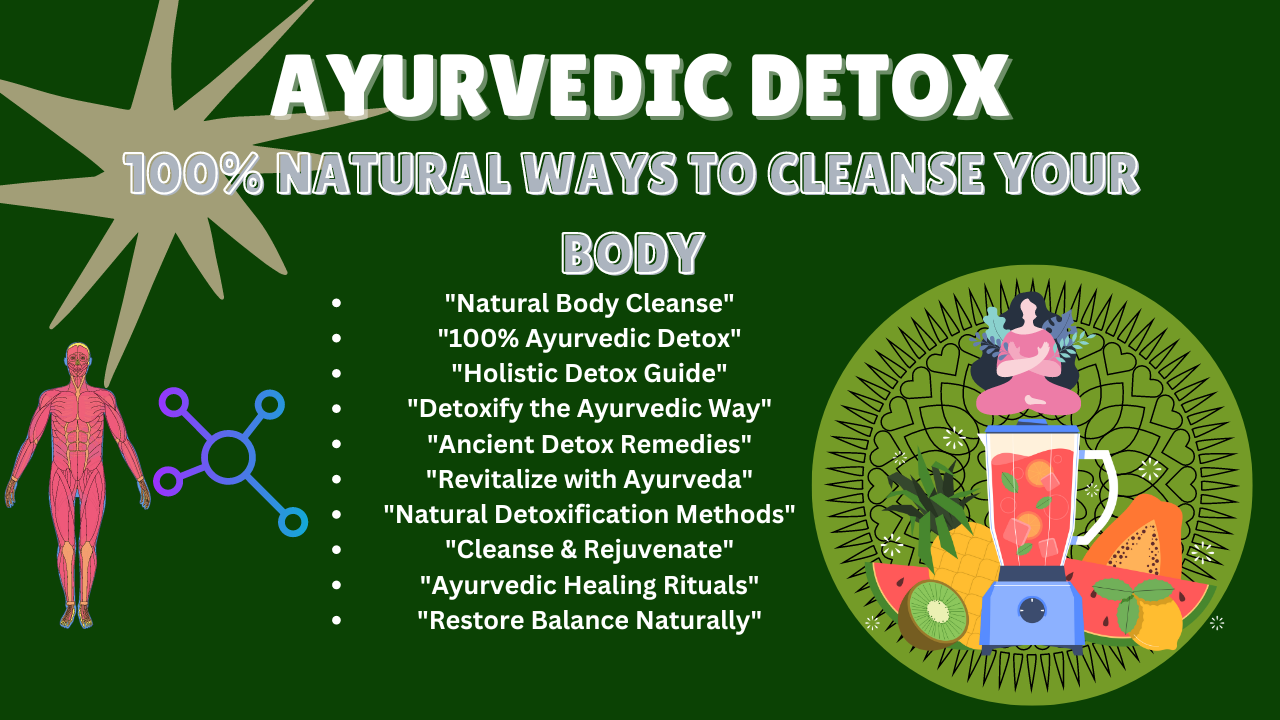
Ayurvedic Detox
Ayurvedic Detox our fast-paced modern world, the idea of detoxification has become more popular than ever. ayurvedic detox With toxins accumulating from pollution, processed foods, stress, and daily life, many seek ways to cleanse their bodies and restore balance. Ayurveda, the ancient Indian system of medicine, offers time-tested and holistic detoxification methods that are 100% natural, gentle, and effective.
Ayurvedic detox or “Panchakarma,” is not just about cleansing the body—it’s about rejuvenating the mind, body, and spirit. This comprehensive approach to detoxification focuses on removing toxins, or “ama,” from the body, restoring balance to the doshas (Vata, Pitta, and Kapha), and promoting overall health and vitality.
In this blog post, we’ll explore the principles behind Ayurvedic detox, delve into natural methods to cleanse your body, and provide practical tips for incorporating these practices into your daily routine.
Understanding Ayurvedic Detox
What is Ama?

In Ayurveda, “ama” refers to toxic, undigested food particles that accumulate in the body, often due to poor digestion, unhealthy eating habits, and exposure to environmental toxins. Ama is considered the root cause of many diseases and imbalances in the body. When ama builds up, it can block the channels in the body, leading to sluggishness, low energy, digestive issues, and even chronic illness.
The goal of Ayurvedic detox is to eliminate ama from the body and restore the natural state of balance, known as “svastha.” This process is not just physical but also involves mental and emotional detoxification, as Ayurveda views the body, mind, and spirit as interconnected.
Table of Contents
The Role of Doshas in Detoxification
According to Ayurveda, everyone has a unique constitution, or “prakriti,” which is determined by the balance of the three doshas: Vata (air and space), Pitta (fire and water), and Kapha (earth and water). Each person’s dosha balance affects their physical, mental, and emotional characteristics.
When the doshas are out of balance, it can lead to the accumulation of ama and other health issues. Ayurvedic detox is tailored to each individual’s dosha type, focusing on restoring balance and promoting optimal health.
Natural Ayurvedic Detox Methods
Ayurvedic detox is gentle yet powerful, relying on natural methods that work in harmony with the body’s own detoxification processes. Here are some of the most effective Ayurvedic practices for cleansing the body naturally.
Panchakarma: The Ultimate Ayurvedic Detox
Panchakarma is Ayurveda’s most comprehensive detoxification and rejuvenation program. It involves five (pancha) therapeutic treatments (karma) designed to cleanse the body of toxins and restore balance to the doshas. These treatments include:
- Vamana (Therapeutic Emesis): Inducing vomiting to eliminate toxins from the stomach and respiratory tract. This is particularly effective for Kapha-related imbalances.
- Virechana (Purgation Therapy): Using natural laxatives to cleanse the intestines, mainly targeting Pitta-related toxins.
- Basti (Enema Therapy): Administering herbal enemas to cleanse the colon, focusing on Vata-related toxins.
- Nasya (Nasal Cleansing): Instilling herbal oils into the nostrils to cleanse the sinuses and improve respiratory health.
- Raktamokshana (Bloodletting): Removing small amounts of blood to detoxify the blood and treat skin conditions. This is rarely used today and is often substituted with herbal remedies.
Panchakarma is best performed under the guidance of a qualified Ayurvedic practitioner, as it involves a specific preparation phase (Purvakarma) and follow-up care (Paschatkarma) to ensure its effectiveness and safety.
Ayurvedic Diet for Detoxification
Diet plays a crucial role in Ayurvedic detox. Eating the right foods can help you cleanse the body, improve digestion, and balance the doshas. Here are some key dietary principles for Ayurvedic detox:
- Eat Fresh and Seasonal Foods: Fresh, organic, and seasonal foods are rich in prana (life force) and help to nourish the body while eliminating toxins. Avoid processed, packaged, and leftover foods, as they can contribute to the buildup of ama.
- Include Detoxifying Herbs and Spices: Ayurvedic herbs and spices like turmeric, ginger, cumin, coriander, and fennel are known for their detoxifying properties. They help to stimulate digestion, boost metabolism, and cleanse the body of toxins.
- Drink Warm Water with Lemon: Starting your day with a glass of warm water with fresh lemon juice helps to flush out toxins, stimulate digestion, and alkalize the body.
- Avoid Heavy, Oily, and Fried Foods: These foods can be difficult to digest and can contribute to the accumulation of ama. Instead, opt for light, easy-to-digest meals that are cooked with minimal oil and spices.
- Practice Mindful Eating: Eating mindfully means paying attention to your food, chewing thoroughly, and eating in a calm and relaxed environment. This helps to improve digestion and prevent the buildup of ama.
Ayurvedic Herbal Remedies
Ayurveda offers a variety of herbal remedies that support detoxification and promote overall health. Some of the most effective Ayurvedic herbs for detox include:
- Triphala: A blend of three fruits (Amalaki, Bibhitaki, and Haritaki), Triphala is a powerful detoxifier that helps to cleanse the colon, improve digestion, and eliminate toxins from the body.
- Neem: Known for its antibacterial and antifungal properties, neem is used in Ayurveda to purify the blood, support liver function, and treat skin conditions.
- Turmeric: Turmeric is a potent anti-inflammatory and antioxidant that helps to detoxify the liver, improve digestion, and boost the immune system.
- Guggul: A resin from the Commiphora mukul tree, guggul is used in Ayurveda to detoxify the body, reduce cholesterol, and support weight loss.
- Manjistha: This herb is known for its blood-purifying properties and is often used in Ayurvedic detox programs to cleanse the lymphatic system and support healthy skin.
Read More –3 Powerful Ayurvedic Superfoods
Daily Ayurvedic Practices for Detox
In addition to diet and herbal remedies, there are several daily practices in Ayurveda that can support detoxification and promote overall health:
- Oil Pulling: This ancient practice involves swishing a tablespoon of oil (such as sesame or coconut oil) in your mouth for 15-20 minutes before spitting it out. Oil pulling helps to remove toxins from the mouth, improve oral health, and promote overall detoxification.
- Dry Brushing: Using a natural bristle brush to gently exfoliate the skin helps to stimulate lymphatic drainage, improve circulation, and remove dead skin cells. This practice also supports the body’s natural detoxification processes.
- Abhyanga (Self-Massage): Abhyanga is a self-massage with warm oil that helps to nourish the skin, improve circulation, and promote the elimination of toxins. It is especially beneficial for balancing Vata dosha.
- Tongue Scraping: Using a tongue scraper to remove the white coating (ama) from your tongue each morning helps to eliminate toxins, improve digestion, and promote oral hygiene.
- Pranayama (Breathing Exercises): Pranayama, or yogic breathing exercises, help to detoxify the lungs, increase oxygen intake, and promote mental clarity. Practices like Kapalabhati (Skull Shining Breath) and Anulom Vilom (Alternate Nostril Breathing) are particularly effective for detoxification.
- Meditation: Detoxification is not just about cleansing the body—it’s also about clearing the mind. Meditation helps to reduce stress, improve mental clarity, and promote emotional balance, all of which are essential for overall health and well-being.
The Benefits of Ayurvedic Detox
Ayurvedic detox offers numerous benefits that go beyond just cleansing the body. By removing toxins and restoring balance to the doshas, Ayurvedic detox can help to:
- Improve Digestion: By eliminating ama and supporting digestive health, Ayurvedic detox can help to improve digestion, reduce bloating, and prevent digestive disorders.
- Boost Energy Levels: Detoxification helps to remove the sluggishness and fatigue associated with toxin buildup, leading to increased energy levels and vitality.
- Enhance Mental Clarity: Ayurvedic detox can help to clear mental fog, reduce stress, and improve concentration and focus.
- Promote Weight Loss: By improving digestion, boosting metabolism, and eliminating toxins, Ayurvedic detox can support healthy weight loss and weight management.
- Support Immune Function: Detoxification helps to strengthen the immune system, making the body more resilient to illness and disease.
- Improve Skin Health: Ayurvedic detox can help to clear the skin of impurities, reduce inflammation, and promote a healthy, radiant complexion.
Conclusion
Ayurvedic detox is a powerful and holistic approach to cleansing the body, mind, and spirit. By following natural methods that work in harmony with your body’s own detoxification processes, you can remove toxins, restore balance to the doshas, and promote overall health and well-being. Whether you’re looking to improve digestion, boost energy levels, or enhance mental clarity, Ayurvedic detox offers a path to rejuvenation and vitality.Incorporate these Ayurvedic detox practices into your daily routine, and experience the transformative benefits of this ancient healing tradition. With its gentle yet effective approach, Ayurvedic detox can help you achieve a healthier, more balanced life—naturally.
(FAQs)
- How often should I do an Ayurvedic detox?
- The frequency of Ayurvedic detox depends on your individual needs and dosha type. For most people, a seasonal detox (four times a year) is sufficient. However, some may benefit from more frequent detoxification, especially if they experience symptoms of toxin buildup.
- Can I do an Ayurvedic detox at home?
- Yes, many Ayurvedic detox practices can be done at home, such as following a detoxifying diet, taking herbal remedies, and incorporating daily practices like oil pulling and dry brushing. However, if you’re considering a more intensive detox like Panchakarma, it’s best to do so under the guidance of a qualified Ayurvedic practitioner. for images click here Google
- What should I avoid during an Ayurvedic detox?
- During an Ayurvedic detox, it’s important to avoid processed foods, caffeine, alcohol, and heavy, oily, or fried foods. These can contribute to the buildup of ama and hinder the detoxification process. It’s also advisable to avoid stress and excessive physical exertion.
- Can I exercise during an Ayurvedic detox?
- Gentle exercise, such as yoga, walking, or light stretching, is beneficial during an Ayurvedic detox. However, it’s important to avoid intense or strenuous exercise, as it can increase stress on the body and interfere with the detoxification process.
- Is Ayurvedic detox safe for everyone?
- Ayurvedic detox is generally safe for most people, but it’s important to consider your individual health condition and dosha type. If you have any underlying health issues or are pregnant or breastfeeding, it’s best to consult with a healthcare provider or Ayurvedic practitioner before starting a detox program.
- How can I maintain the benefits of Ayurvedic detox?
- To maintain the benefits of Ayurvedic detox, continue to follow a healthy diet, practice daily Ayurvedic routines, and incorporate regular exercise and stress management techniques. Seasonal detoxification and regular self-care practices will help to keep your body, mind, and spirit in balance.





